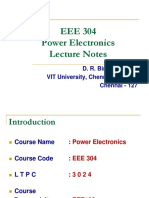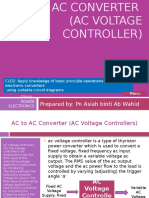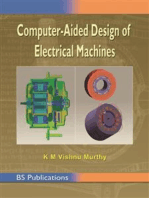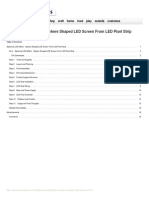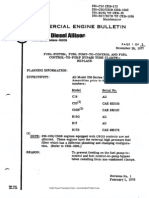3 Phase Full Wave Bridge Converter
3 Phase Full Wave Bridge Converter
Uploaded by
subhasishpodderCopyright:
Available Formats
3 Phase Full Wave Bridge Converter
3 Phase Full Wave Bridge Converter
Uploaded by
subhasishpodderOriginal Description:
Copyright
Available Formats
Share this document
Did you find this document useful?
Is this content inappropriate?
Copyright:
Available Formats
3 Phase Full Wave Bridge Converter
3 Phase Full Wave Bridge Converter
Uploaded by
subhasishpodderCopyright:
Available Formats
1
University of Technology
Laser and Optoelectronics Engineering Department
Laser Engineering Branch
Power electronics 2011-2012
Experiment No.12
Three-Phase Full wave Controlled Converters
(Controlled rectifier)
Experiment aim
The aim of Experiment is to analyze the operation (Switching) of three phase
controlled and semi-controlled rectifiers with resistive and inductive load.
Apparatus
1. Power electronic trainer.
2. Connection wires.
3. Oscilloscope.
Theory
Phase controlled AC-DC converters employing thyristor are extensively used
for changing constant ac input voltage to controlled dc output voltage. In phase-
controlled rectifiers, a thyristor is tuned off as AC supply voltage reverse biases it,
provided anode current has fallen to level below the holding current.
Controlled rectifiers have a wide range of applications, from small rectifiers to
large high voltage direct current (HVDC) transmission systems. They are used for
electrochemical processes, many kinds of motor drives, traction equipment,
controlled power supplies, and many other applications
Three- phase Full wave controlled rectifier:
Fig(1-a) shows the three-phase bridge rectifier. The configuration does not need
any special transformer, and works as a 6-pulse rectifier. The series characteristic
of this rectifier produces a dc voltage twice the value of the half-wave rectifier .
2
University of Technology
Laser and Optoelectronics Engineering Department
Laser Engineering Branch
Power electronics 2011-2012
Fig(3-a): Three-phase full-wave rectifier
Fig(3-b): Three-phase sime control rectifier
3
University of Technology
Laser and Optoelectronics Engineering Department
Laser Engineering Branch
Power electronics 2011-2012
The load average voltage is given by:
Fig(2) shows the voltages of each half-wave bridge of this topology
pos
D
and
neg
D
, the total instantaneous dc voltage v
D
, and the anode-to-cathode voltage v
AK
in one
of the bridge thyristors. The maximum value of v
AK
is 3 V
max
, which is the same
as that of the half-wave converter .
Fig(2)
4
University of Technology
Laser and Optoelectronics Engineering Department
Laser Engineering Branch
Power electronics 2011-2012
Procedure
1. Connect the three-phase full wave controlled rectifier circuit shown in
Fig.(1-a) on the power electronic trainer.
2. Turn on the power
3. By use oscilloscope, plot the input and output waveforms on the same graph
paper" same axis".
4. Measure the average and RMS output voltage by connect the AVO meter
across load resistance.
5. Turn off the power
6. Use an inductive load. With L=100mH measure the output voltage and plot
the output waveform.
7. Repeat step 6 with L=100mH measure the output voltage and plot the output
waveforms.
8. Repeat step 6 & 7 with connect the freewheeling diode across the load.
9. Connect the three-phase bridge half-control rectifier circuit shown in Fig.(1-
b).
10. Repeat steps (2-7).
Discussion and calculations
1. Compare between the practical and theoretical results for input and output
voltages and currents.
2. Design a high voltage power supply for CO
2
laser, when the optical output
power is 12 watt. The current and voltage electronically highly stabilized DC
power unit has a nominal output 70mA and 6kV. Pumping under optimal
conditions (maximum laser output), a current of 20mA at 4 kV is observed.
3. Compare between the three-phase half-wave controlled rectifier and three-
phase full-wave controlled rectifier
You might also like
- Zaragoza Dominic L. EE07L TFDocument9 pagesZaragoza Dominic L. EE07L TFDominic ZaragozaNo ratings yet
- Design of Electrical Circuits using Engineering Software ToolsFrom EverandDesign of Electrical Circuits using Engineering Software ToolsNo ratings yet
- Buck ConverterDocument73 pagesBuck Convertermounicapaluru_351524No ratings yet
- Z Source ConverterDocument12 pagesZ Source Converterravirnjn88No ratings yet
- UPFCDocument10 pagesUPFCAJAN ANo ratings yet
- Modelling and Simulation of Protection For Power Transformer at Primary Substation by Using Differential ProtectionDocument5 pagesModelling and Simulation of Protection For Power Transformer at Primary Substation by Using Differential Protectionbalasim HusseinNo ratings yet
- Voltage Controlled OscillatorDocument7 pagesVoltage Controlled OscillatorHemantha DalugamaNo ratings yet
- A Novel ZVS-ZCS Bi-Directional Flyback DC-DCDocument6 pagesA Novel ZVS-ZCS Bi-Directional Flyback DC-DCArceu CamposNo ratings yet
- Eee 304 Lecture Notes - 1Document171 pagesEee 304 Lecture Notes - 1Haritha RkNo ratings yet
- Prof. D. M. Chandwadkar, K.K. Wagh Institute of Engineering Education & Research, NashikDocument40 pagesProf. D. M. Chandwadkar, K.K. Wagh Institute of Engineering Education & Research, NashikmaheshmonyNo ratings yet
- Battery 24v 40ah 22 PDFDocument10 pagesBattery 24v 40ah 22 PDFramana3339No ratings yet
- Multilevel InverterDocument92 pagesMultilevel Invertermohitsingh421421No ratings yet
- DC-DC Converter Fault (Important Paper)Document16 pagesDC-DC Converter Fault (Important Paper)shan.rahmanNo ratings yet
- Commutation Circuits PDFDocument2 pagesCommutation Circuits PDFRalph0% (1)
- Control of Bidirectional DC-DC Converter For SupercapacitorDocument8 pagesControl of Bidirectional DC-DC Converter For Supercapacitorhmaker1978No ratings yet
- Static Series Compensation (Benny Yeung)Document9 pagesStatic Series Compensation (Benny Yeung)haseeb khanNo ratings yet
- Step-Down Cycloconverter Explained - Electrical ConceptsDocument5 pagesStep-Down Cycloconverter Explained - Electrical ConceptsMohammad HamamdNo ratings yet
- Triac OperationDocument8 pagesTriac OperationArpit PatelNo ratings yet
- Solid State VoltmeterDocument10 pagesSolid State VoltmeterKunal VermaNo ratings yet
- Scott Connection of TransformersDocument22 pagesScott Connection of TransformersakhilNo ratings yet
- Multilevel Inverter CascadedDocument20 pagesMultilevel Inverter Cascadedpepikli100% (1)
- Boost ConverterDocument8 pagesBoost Converterhamza abdo mohamoudNo ratings yet
- Design Bi-Directional Charger For Phev Application: Chaudhari Tejal A., Bariya Chetan K., Upadhyay Chetan DDocument6 pagesDesign Bi-Directional Charger For Phev Application: Chaudhari Tejal A., Bariya Chetan K., Upadhyay Chetan Dmohd786azharNo ratings yet
- EXPERIMENT 1 - Diode As RectifierDocument5 pagesEXPERIMENT 1 - Diode As RectifierSamNo ratings yet
- Ac Voltage Controller Using Thyristor Project Report by SandeepDocument29 pagesAc Voltage Controller Using Thyristor Project Report by SandeepSANDEEP DHANDA100% (1)
- UNIT 1-DC Power SupplyDocument30 pagesUNIT 1-DC Power SupplyMuizz ZainolNo ratings yet
- Real and Reactive Power Flow Control With Upfcconnected To A Transmission LineDocument7 pagesReal and Reactive Power Flow Control With Upfcconnected To A Transmission LineSravan GuptaNo ratings yet
- Genaral Details of A TransformerDocument3 pagesGenaral Details of A TransformershaluNo ratings yet
- Analysis and Application of Scott ConnectionDocument11 pagesAnalysis and Application of Scott ConnectionRam Uday MandalNo ratings yet
- A McMurray InverterDocument2 pagesA McMurray Inverteranshu71% (7)
- The Reduction of Total Harmonic Distortion For The Multilevel Converter Using Genetic Algorithms Optimization MethodDocument15 pagesThe Reduction of Total Harmonic Distortion For The Multilevel Converter Using Genetic Algorithms Optimization MethodMohammad reza eesazadehNo ratings yet
- Unit-2 RelaysDocument73 pagesUnit-2 RelaysmurthypriyaphdNo ratings yet
- ELEC331 Lab Experiment#1Document16 pagesELEC331 Lab Experiment#1DavidNo ratings yet
- Project Reprt333Document49 pagesProject Reprt333dhirajsingh_avit83% (6)
- Induction GeneratorDocument5 pagesInduction GeneratorAmarjeetRanjanNo ratings yet
- Single Phase Half Wave Controlled ConverterDocument7 pagesSingle Phase Half Wave Controlled ConverterAlexNo ratings yet
- Q1. What Do You Mean by Harmonics?Document3 pagesQ1. What Do You Mean by Harmonics?vinesh_viswanathan_3100% (1)
- Performance Analysis of Asymmetrical Cascaded H-Bridge Nine Level Inverter With Photovoltaic ArraysDocument4 pagesPerformance Analysis of Asymmetrical Cascaded H-Bridge Nine Level Inverter With Photovoltaic ArraysijsretNo ratings yet
- "Single Phase Full Wave Rectifier": Power Point Presentation OnDocument12 pages"Single Phase Full Wave Rectifier": Power Point Presentation Onshadan alamNo ratings yet
- Ch8 Output Stages and Power AmplifiersDocument20 pagesCh8 Output Stages and Power Amplifiers陳冠邑No ratings yet
- Classifications of Chopper (Suha Dalaf)Document28 pagesClassifications of Chopper (Suha Dalaf)noor deenNo ratings yet
- ABCD ParametersDocument3 pagesABCD ParametersKiranreddy BurriNo ratings yet
- Four Quadrant OperationDocument9 pagesFour Quadrant OperationMOTILAL SUTHAR215291No ratings yet
- Circuits Devices and ApplicationsDocument30 pagesCircuits Devices and ApplicationsTe NgNo ratings yet
- DC Bus Voltage RegulationDocument2 pagesDC Bus Voltage RegulationHasRasfaNo ratings yet
- Unity Power FactorDocument6 pagesUnity Power FactorReshmi Parikal RaghavanNo ratings yet
- Diode RectifiersDocument23 pagesDiode Rectifierskaliman2010No ratings yet
- Control of HVDC Transmission System Based On MMCDocument22 pagesControl of HVDC Transmission System Based On MMCAnand Parakkat ParambilNo ratings yet
- DC Link CurrentDocument8 pagesDC Link CurrentsubbannaNo ratings yet
- Modelling and Simulation of High Step Up DC To AC Converter For Microsource ApplicationDocument5 pagesModelling and Simulation of High Step Up DC To AC Converter For Microsource ApplicationtheijesNo ratings yet
- Cuk, Sepic Zeta NptelDocument20 pagesCuk, Sepic Zeta NptelAvinash Babu KmNo ratings yet
- AC DC Railway Electrification and Protection: November 2014Document43 pagesAC DC Railway Electrification and Protection: November 2014Akhilesh kumar Srivastava100% (1)
- Practical No 1 Name M.Jawad Roll No 21Bsc01 Semester 4 Sir Bilal HussainDocument5 pagesPractical No 1 Name M.Jawad Roll No 21Bsc01 Semester 4 Sir Bilal HussainZAIN UL ABIDENNo ratings yet
- DC DC Converters (Lecture#03)Document40 pagesDC DC Converters (Lecture#03)usmangul_23No ratings yet
- Chapter 5 AC ConverterDocument27 pagesChapter 5 AC ConverterArjun KumarNo ratings yet
- DC - Ac Inv.Document82 pagesDC - Ac Inv.Jegadeeswari GNo ratings yet
- Component of HVDC Transmission NetworkDocument5 pagesComponent of HVDC Transmission NetworkIqbalilah RamdaniNo ratings yet
- M-6017-M50B Control Pack - 2018 Coyote 5.0L Manual TransDocument23 pagesM-6017-M50B Control Pack - 2018 Coyote 5.0L Manual Transjoecosta77No ratings yet
- How To Say I Forgot My Homework in JapaneseDocument4 pagesHow To Say I Forgot My Homework in Japaneseafnairleisvwdn100% (1)
- JOB Perfomance AppraisalDocument3 pagesJOB Perfomance AppraisalLyneth Ann RuleNo ratings yet
- Water Supply and Sanitation in Nigeria: An AMCOW Country Status OverviewDocument36 pagesWater Supply and Sanitation in Nigeria: An AMCOW Country Status OverviewnewworldosemwegieNo ratings yet
- Ch. 10 - Malhotra 6th EditionDocument18 pagesCh. 10 - Malhotra 6th EditionCarlos Andres RodriguezNo ratings yet
- No Section Taken From The Software Requirement Document The Requirement FactorsDocument3 pagesNo Section Taken From The Software Requirement Document The Requirement FactorsFriskaNo ratings yet
- CIVL4430 - Topic 5b - Travel Demand ModellingDocument74 pagesCIVL4430 - Topic 5b - Travel Demand ModellingvaseemmanafNo ratings yet
- Soundscapeand The BuiltEnvironmentDocument324 pagesSoundscapeand The BuiltEnvironmentConstanza Hernández EstatópulosNo ratings yet
- VLSI Interview QuestionDocument17 pagesVLSI Interview QuestionamiteshtripathiNo ratings yet
- Spherical LED Matrix - Sphere Shaped LED Screen From LED Pixel StripDocument16 pagesSpherical LED Matrix - Sphere Shaped LED Screen From LED Pixel StripGuillermo BianchiniNo ratings yet
- ANSYS Meshing Users Guide r170Document522 pagesANSYS Meshing Users Guide r170Wai Yan Thet PaingNo ratings yet
- Did You Know?: About UNWTO Our PrioritiesDocument2 pagesDid You Know?: About UNWTO Our PrioritiesMaria TamasanNo ratings yet
- LA RP6D SERIE6RS Brochure 4p 6697647A1 LR EN-FR-ES-1Document4 pagesLA RP6D SERIE6RS Brochure 4p 6697647A1 LR EN-FR-ES-1Aleksandar SavicNo ratings yet
- Lps Prayer ManualDocument36 pagesLps Prayer ManualSureen NarangNo ratings yet
- Afrah Azzahira Wismono - 008202000053 - Assignment 6Document7 pagesAfrah Azzahira Wismono - 008202000053 - Assignment 6Afrah AzzahiraNo ratings yet
- SilverLinings PlaybookDocument3 pagesSilverLinings Playbookvadrarajal9No ratings yet
- Assigntment Math Group 3 s33Document21 pagesAssigntment Math Group 3 s33Alya BalqisNo ratings yet
- Detroit Diesel Allison: Commercial Engine BulletinDocument5 pagesDetroit Diesel Allison: Commercial Engine Bulletinoscar horacio floresNo ratings yet
- 01 Cable BoxDocument7 pages01 Cable BoxNajamNo ratings yet
- 020 Royal Rozep 20KDocument7 pages020 Royal Rozep 20KLiliana BeruNo ratings yet
- Astm c470Document4 pagesAstm c470jem gui50% (2)
- O Neil's AssignmentDocument2 pagesO Neil's Assignmentjaveria_ashiqNo ratings yet
- Studi Kasus Kandungan Formalin Pada Ikan Teri Nasi (Stolephorus Commersoni Lac.) Asin Kering Di Pasar Rau Serang Banten - DocDocument4 pagesStudi Kasus Kandungan Formalin Pada Ikan Teri Nasi (Stolephorus Commersoni Lac.) Asin Kering Di Pasar Rau Serang Banten - DocRini YanuartiNo ratings yet
- Change Request Form TEMPLATE ONLYDocument1 pageChange Request Form TEMPLATE ONLYrowaxeNo ratings yet
- ROA SS22-283 Gar 45 DBN Serongga Kalsel (Replica)Document2 pagesROA SS22-283 Gar 45 DBN Serongga Kalsel (Replica)Jake DylanNo ratings yet
- AP Chemistry - Oxidation Numbers PracticeDocument2 pagesAP Chemistry - Oxidation Numbers Practicemartialartsgrl21No ratings yet
- Amended MGT702 Major Project 2021Document23 pagesAmended MGT702 Major Project 2021kajal prasadNo ratings yet
- 1.1 Chương 1 Thiết bị mạng và hạ tầng mạngDocument17 pages1.1 Chương 1 Thiết bị mạng và hạ tầng mạng22520101No ratings yet
- WWW - Upjob, In: General Studies - Ii (Csat)Document25 pagesWWW - Upjob, In: General Studies - Ii (Csat)Sachin KulshreshthaNo ratings yet








